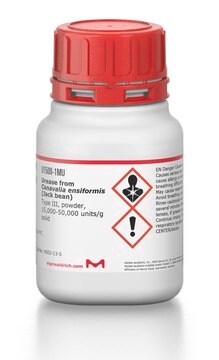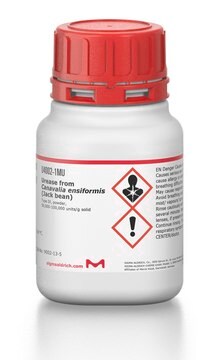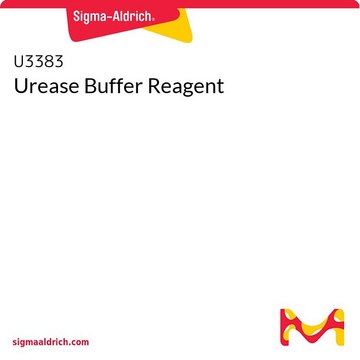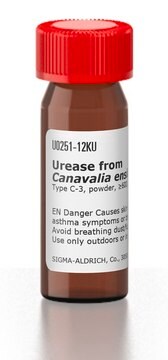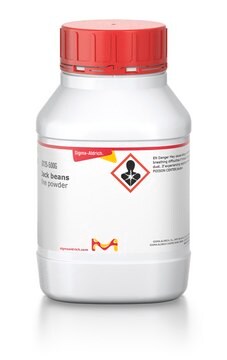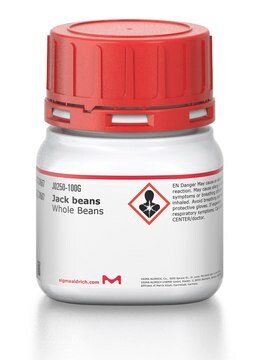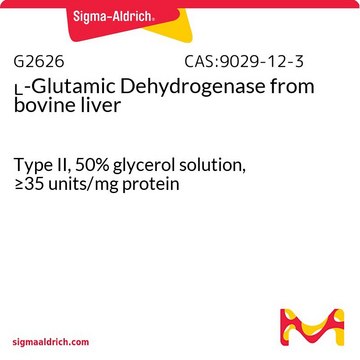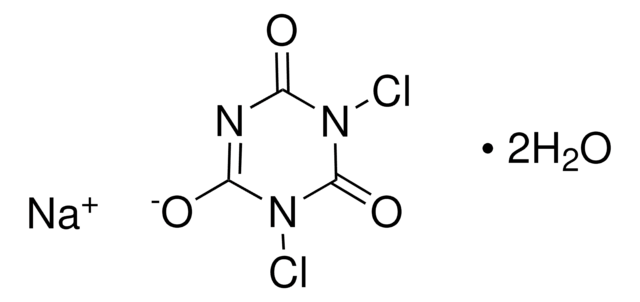Alle Fotos(1)
Wichtige Dokumente
U1875
Urease aus Canavalia ensiformis (Jack bean)
Type III, glycerol solution, 500-800 units/mL
Synonym(e):
Jack bean urease, Urea amidohydrolase
Anmeldenzur Ansicht organisationsspezifischer und vertraglich vereinbarter Preise
Alle Fotos(1)
About This Item
CAS-Nummer:
MDL-Nummer:
UNSPSC-Code:
12352204
eCl@ss:
32160410
NACRES:
NA.54
Empfohlene Produkte
Biologische Quelle
Canavalia ensiformis
Qualitätsniveau
Typ
Type III
Form
glycerol solution
Mol-Gew.
~544620
Konzentration
500-800 units/mL
Lagertemp.
2-8°C
Suchen Sie nach ähnlichen Produkten? Aufrufen Leitfaden zum Produktvergleich
Allgemeine Beschreibung
Molekulargewicht der Untereinheit: ~90,770
Besteht aus sechs Untereinheiten mit einem Molekulargewicht von ~544,620
Besteht aus sechs Untereinheiten mit einem Molekulargewicht von ~544,620
Urease of jack bean (Canavalia ensiformis), a hexamer of a single chain of 840 amino acid residues, is found in plants, bacteria, fungi, algae, and soil. It is considered the first nickel-containing enzyme and the first enzyme to be crystallized. Ureases exist in several isoforms, some are jack bean urease (JBURE-I), canatoxin (CNTX), and JBURE-IIB. JBURE-I is more abundant than the other two isoforms. Ureases are found in mature seeds.
Anwendung
Urease from Canavalia ensiformis (Jack bean) has been used:
- to assay creatine and creatine phosphate using the sample extracted from the left ventricle (LV) and septal tissue
- to determine the concentration of urea in a stabilized urine sample
- as one of the standards to measure the urease activity of plant extracts
Biochem./physiol. Wirkung
In plants, ureases are essential for the bioavailability/metabolism of nitrogen in nature and defense mechanisms. Ureases are metalloenzymes that catalyze the hydrolysis of urea to release ammonia a nitrogen source for growth and carbon dioxide. They exhibit internal peptides-mediated insecticidal action and fungicidal activity.
Urease activity has been shown to be inhibited by benzpyrene following exposure to light. This inhibition was due to the effect of benzpyrene on urease′s sulfhydryl groups.
Einheitendefinition
One micromolar unit will liberate 1.0 μmole of NH3 from urea per min at pH 7.0 at 25 °C. It is equivalent to 1.0 I.U. or 0.054 Sumner unit (1.0 mg ammonia nitrogen in 5 minutes at pH 7.0 at 20 °C)
Signalwort
Danger
H-Sätze
Gefahreneinstufungen
Eye Irrit. 2 - Resp. Sens. 1 - Skin Irrit. 2 - STOT SE 3
Zielorgane
Respiratory system
Lagerklassenschlüssel
10 - Combustible liquids
WGK
WGK 1
Flammpunkt (°F)
Not applicable
Flammpunkt (°C)
Not applicable
Hier finden Sie alle aktuellen Versionen:
Besitzen Sie dieses Produkt bereits?
In der Dokumentenbibliothek finden Sie die Dokumentation zu den Produkten, die Sie kürzlich erworben haben.
Kunden haben sich ebenfalls angesehen
Effect of light-activated benzpyrene on urease activity.
G C MILLS et al.
Cancer research, 13(1), 69-72 (1953-01-01)
Nizam Uddin et al.
Fitoterapia, 84, 202-207 (2012-10-30)
Seven constituents were isolated from the stems of Lawsonia alba Lam., following an activity-guided isolation, which include two new constituents, namely lawsorosemarinol (1) and lawsofructose (2), one known compound 2-(β-d-glucopyranosyloxy)-1, 4-naphthoquinone (3) and four compounds, 4-hydroxy coumarine (4), 3-(4-hyroxyphenyl)-triacontyl-(Z)-propenoate (5)
Brian H Eisner et al.
The Urologic clinics of North America, 40(1), 21-30 (2012-11-28)
This article reviews the data on pharmacologic treatment of kidney stone disease, with a focus on prophylaxis against stone recurrence. One of the most effective and important therapies for stone prevention, an increase in urine volume, is not discussed because
Yi Wen et al.
Journal of bacteriology, 195(3), 444-452 (2012-10-30)
Urease is an essential component of gastric acid acclimation by Helicobacter pylori. The increased level of urease in gastric acidity is due, in part, to acid activation of the two-component system consisting of the membrane sensor HP0165 (ArsS) and its
Lisa G Kuhns et al.
The Biochemical journal, 450(1), 141-148 (2012-11-28)
The persistence of the gastric pathogen Helicobacter pylori is due in part to urease and Msr (methionine sulfoxide reductase). Upon exposure to relatively mild (21% partial pressure of O2) oxidative stress, a Δmsr mutant showed both decreased urease specific activity
Artikel
probiotics-and-human
Unser Team von Wissenschaftlern verfügt über Erfahrung in allen Forschungsbereichen einschließlich Life Science, Materialwissenschaften, chemischer Synthese, Chromatographie, Analytik und vielen mehr..
Setzen Sie sich mit dem technischen Dienst in Verbindung.